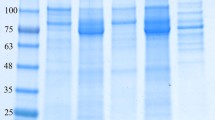Abstract
Cellulosome-like complexes were identified in the broth and sonic extracts of cellobiose-and cellulose-grown cells ofBacteroides cellulosolvens. The extracellular fractions contained three to four major polypeptides and several minor polypeptide bands that were localized in two major gel filtration peaks indicating average molecular weights of about 700 kDa and >10 MDa. A relatively large molecular weight component (Mr 230 kDa) was found to contain carbohydrate, but no apparent enzymatic activity of its own could be detected. The cell sonicate displayed a more complicated polypeptide profile, and glycosylated polypeptides were larger (ca. 310 and 290 kDa) than that of the extracellular fraction. The 230-kDa extracellular component interacted strongly with the GSI isolectin fromGriffonia simplicifolia, exhibited immunochemical cross-reactivity with the S1 subunit of the cellulosome fromClostridium thermocellum, and displayed anomalous pH- and salt-dependent migratory behavior in SDS-PAGE. Taken together, this evidence strongly suggests a structural similarity between the glycoconjugates of these two distinct cellulolytic bacteria. A major 84-kDa polypeptide was identified as a xylanase, and a 50-kDa polypeptide displayed endoglucanase activity. Additional biochemical and cytochemical evidence indicated that cellulosome-like cellulolytic complexes are associated with the cell surface in this bacterium.
Similar content being viewed by others
Literature Cited
Bayer EA, Lamed R (1986) Ultrastructure of the cell surface cellulosome ofC. thermocellum and its interaction with cellulose. J Bacteriol 167:828–836
Bayer EA, Kenig R, Lamed R (1983) Adherence ofClostridium thermocellum to cellulose. J Bacteriol 156:818–827
Beguin P (1983) Detection of cellulase activity in polyacrylamide gels using Congo red-stained agar replicas. Anal Biochem 131:333–336
Gerwig GJ, de Waard P, Kamerling JP, Vliegenthart JFG, Morgenstern E, Lamed R, Bayer EA (1989) NovelO-linked carbohydrate chains in the cellulase complex (cellulosome) ofClostridium thermocellum. J Biol Chem 264:1027–1035
Giuliano C, Khan AW (1984) Cellulase and sugar formation byBacteroides cellulosolvens, a newly isolated cellulolytic anaerobe. Appl Environ Microbiol 48:446–448
Giuliano C, Khan AW (1985) Conversion of cellulose to sugars by resting cells of a mesophilic anaerobe,Bacteroides cellulosolvens. Biotechnol Bioeng 27:980–983
Lamed R, Bayer EA (1988) Cellulosomes fromClostridium thermocellum. Methods Enzymol 160:472–482
Lamed R, Bayer EA (1988) The cellulosome concept: exocellular/extracellular enzyme reactor centers for efficient binding and cellulolysis. In: Aubert J-P, Beguin P, Millet J (eds), Biochemistry and genetics of cellulose degradation. London, San Diego, New York: Academic Press, pp 101–116
Lamed R, Bayer EA (1988) The cellulosome ofClostridium thermocellum. Adv Appl Microbiol 33:1–46
Lamed R, Bayer EA (1990) Cellulose degradation by thermophilic anaerobic bacteria. In: Weimer PJ, Haigler CA (eds), Biosynthesis and biodegradation of cellulose and cellulose materials. New York: Marcel Dekker, in press
Lamed R, Setter E, Bayer EA (1983) Characterization of a cellulose-binding, cellulase-containing complex inClostridium thermocellum. J Bacteriol 156:828–836
Lamed R, Setter E, Kenig R, Bayer EA (1983) The cellulosome: a discrete cell surface organelle ofClostridium thermocellum which exhibits separate antigenic, cellulose-binding and various cellulolytic activities. Biotechnol Bioeng Symp 13:163–181
Lamed R, Naimark J, Morgenstern E, Bayer EA (1987) Specialized cell surface structures in cellulolytic bacteria. J Bacteriol 169:3792–3800
Lamed R, Naimark J, Morgenstern E, Bayer EA (1987) Scanning electron microscopic delineation of bacterial surface topology using cationized ferritin. J Microbiol Methods 7:233–240
Miller GLR, Blum WE, Burton AL (1960) Measurements of carboxymethylcellulase activity. Anal Biochem 2:127–132
Morgenstern E, Bayer EA, Lamed R. Anomalous dissociative behavior of the major glycosylated component of the cellulosome ofClostridium thermocellum. Submitted
Morag (Morgenstern) E, Bayer EA, Lamed R. Cellulosomal and noncellulosomal xylanases ofClostridium thermocellum: relationship to cellulose-degrading enzymes. J Bacteriol, in press
Murray WD (1985) Increased cellulose hydrolysis byBacteroides cellulosolvens in a simplified synthetic medium. J Biotechnol 3:131–140
Murray WD (1986) Symbiotic relationship ofBacteroides cellulosolvens andClostridium saccharolyticum in cellulose fermentation. Appl Environ Microbiol 51:710–715
Murray WD, Sowden LC, Colvin JR (1984)Bacteroides cellulosolvens sp. nov., a cellulolytic species from sewage sludge. Int J Syst Bacteriol 34:185–187
Murray WD, Sowden LC, Colvin JR (1986) Localization of the cellulase activity ofBacteroides cellulosolvens. Lett Appl Microbiol 3:69–72
Rasmussen MA, Hespell RB, White BA, Bothst RJ (1988) Inhibitory effects of methyl cellulose on cellulose degradation byRuminococcus flavefaciens. Appl Environ Microbiol 54:890–897
Segrest JP, Jackson RL (1972) Molecular weight determination of glycoproteins by polyacrylamide gel electrophoresis in sodium dodecyl sulfate. Methods Enzymol 28:54–63
Author information
Authors and Affiliations
Rights and permissions
About this article
Cite this article
Lamed, R., Morag (Morgenstern), E., Mor-Yosef, O. et al. Cellulosome-like entities inBacteroides cellulosolvens . Current Microbiology 22, 27–33 (1991). https://doi.org/10.1007/BF02106209
Issue Date:
DOI: https://doi.org/10.1007/BF02106209




